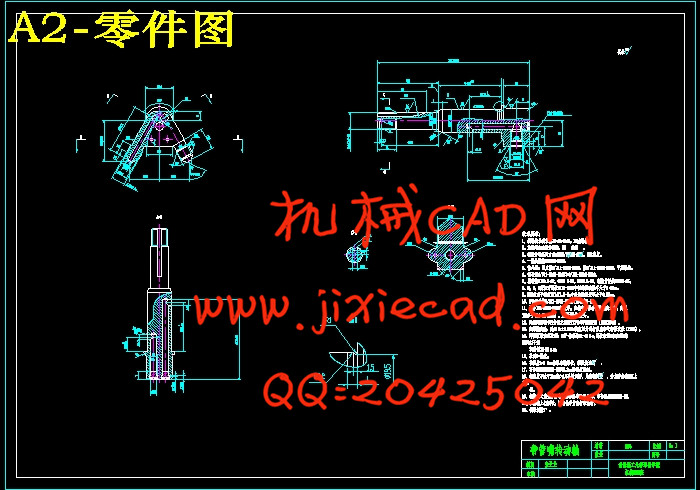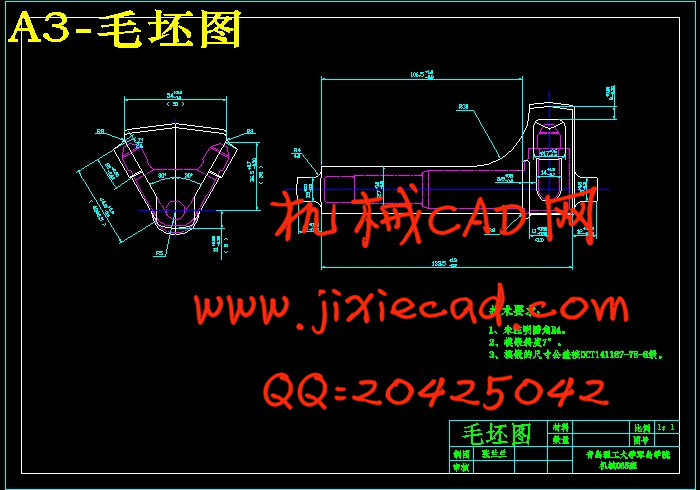设计简介
本毕业设计是带管嘴转动轴的工艺规程及工装设计。
工艺规程说明书包括零件图的工艺分析(其中包括零件的结果分析;技术条件分析;材料及其切削特性的分析和零件的工艺性分析等);毛坯的设计(其中包括毛坯种类的确定;毛坯的工艺要求;毛坯的余量和公差等);工艺规程设计(其中包括工艺路线的制定;工序尺寸的制定等)。还有主要表面的加工方法及其表面质量和尺寸精度的保证方法。热处理工序和辅助工序的安排,零件的化学成分,机械性能及零件在主机上的作用及工作环境等内容。
夹具设计内容是车夹的设计。有设计方案;总体说明;夹具的构造特点及原则;夹具体的设计(包括夹具体毛坯结构的选择;引导装置的设计;定位装置的设计;夹具体外廓尺寸的设计等方面),还包括定位,夹紧方案的选择,定位元件配合性质以及误差计算等内容。
从零件的构形,技术要求和材料等几方面的分析,主要的工艺关键是精度的保证问题。因此在设计工艺规程的过程当中,首先要考虑该零件怎样加工,以哪个部位为基准,怎样定位才能保证其精度要求。对零件的刀具也有要求。因为该材料的强度高,导热系数偏低,故切削力大,切削温度高,刀具磨损快,刀具使用寿命短,断屑也稍难。所以必须采用耐磨性强的刀具材料。因此采用强度比其它刃具钢约高30%~50%的高速钢。
关于零件的位置尺寸和位置关系。因为尺寸关系复杂,必须对设计基准进行细致的分析。值得注意的是这其中可能有基准的转换问题,所以在设计工序和确定原始基准,原始尺寸和原始偏差时,应予以充分地注意。
关键词:轴、工艺规程、夹具
Abstract
The graduation project is the nozzle rotation axis with process planning and tooling design
Process planning manual analysis of the technology, including parts diagram (including parts of the results of analysis; technical requirements analysis; materials and their cutting characteristics and components of the process of analysis, etc.); rough design (including the rough species identification; Blank process requirements; Blank margin and tolerance, etc.); process planning (including development of process routes; size of the development process, etc.). There are major surface processing method and its surface quality and dimensional accuracy assurance methods. Heat treatment processes and supporting processes of arrangement, part of the chemical composition, mechanical properties and components on the host role and working environment and so on.
Fixture design folder content is car design. A design; general description; fixture structural characteristics and principles; folder for the specific design (including the folder structure of the specific choice of blank; guide device design; positioning device design; fixture in vitro profile of the design size, etc.), but also positioning, clamping scheme selection, positioning device with the nature of the error calculation and so on.
From the parts configuration, technical requirements and materials aspects of the analysis, the main process is the key to accuracy guarantees. Therefore, the process of design process planning, we should first consider how the process of the part to which parts of the base, how can we ensure positioning accuracy. On the part of the tool is also required. Because the material strength, low thermal conductivity, so cutting power, cutting temperatures are high, rapid tool wear, tool life is short, chip breaking is also a little difficult. Therefore, we must use the tool material wear resistance. Therefore, other than cutlery steel with strength of about 30% to 50% of high-speed steel.
Position on the part of the relationship between size and location. Because the size of complex relationships, must be a careful analysis of design basis. It is worth noting that there may be a benchmark for the conversion, so in the design process and to determine the original baseline, the original size and the original deviation, should be sufficient attention.
Key Words: axis, process planning, fixture
目录
摘 要 I
Abstract II
1 零件工艺分析说明 1
1.1零件图工艺分析 1
1.1.1零件的结构特点和功能分析 1
1.1.2零件的主要表面及技术要求分析 1
1.1.3零件表面本身精度分析 1
1.1.4表面间的位置精度分析 1
1.1.5零件的其它技术要求 2
1.2零件的材料及可加工性 2
1.3为保证质量的热处理说明 3
2 毛坯设计 4
2.1毛坯种类及其确定 4
2.1.1毛坯种类及其特点 4
2.1.2选择毛坯考虑因素及原则 5
2.2毛坯工艺要求 6
2.2.1模锻件的构造要素 6
2.2.2分模位置的确定 6
2.2.3锤和压力机上模锻件 7
2.2.4圆角半径 8
2.2.5计量保证 9
2.3航空用TC6钛合金锻件技术条件 9
3 工艺路线的设计 12
3.1表面加工方法的选择 12
3.2定位基准的选择 13
3.2.1粗基准的选择 13
3.2.2精基准的选择 13
3.2.3辅助定位基准 13
3.3加工阶段的划分 14
3.3.1加工阶段的任务 14
3.3.2划分加工阶段的原因 14
3.3.3划分阶段的原则 14
3.4工序集中与分散 15
3.4.1工序集中与分散的特点 15
3.4.2工序集中与分散选用 15
3.5加工顺序的安排 16
3.5.1机械加工工序的安排原则 16
3.5.2热处理工序安排 16
3.5.3辅助工序安排 17
3.6工艺路线的制订 18
3.7工艺路线分析 21
3.8工序设计 23
3.8.1加工余量的确定 23
3.8.2工序尺寸的确定 24
3.8.3表面处理层计算 25
3.9机床和工艺装备的选择 26
3.9.1机床的选择原则 26
3.9.2工艺装备的选择 27
4 车床夹具的设计 28
4.1设计方案及说明 28
4.2定位机构 28
4.3夹紧装置 30
4.3.1夹紧装置组成 30
4.3.2夹紧装置的设计要求 31
4.3.3夹紧力的确定 31
4.4夹紧机构 32
4.5夹具体的设计制造 32
4.6夹具定位误差分析 33
5.技术经济分析 34
5.1概述 34
5.2总原则 34
结 论 35
致 谢 36
参考文献 37




